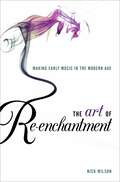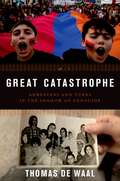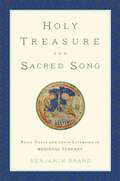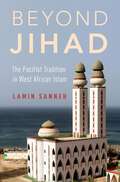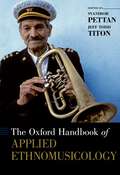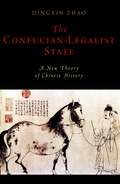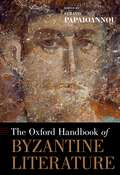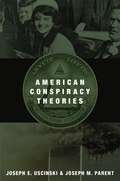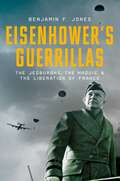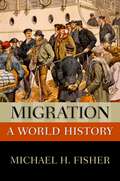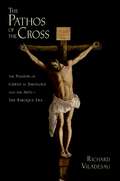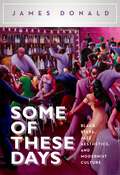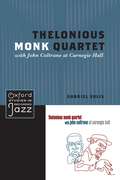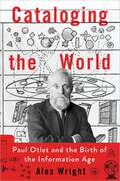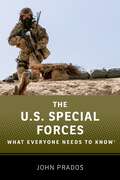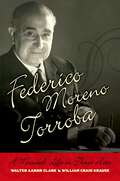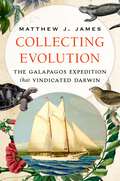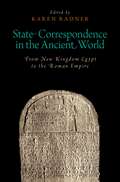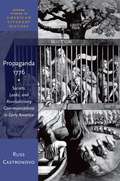- Table View
- List View
The Art of Re-enchantment: Making Early Music in the Modern Age
by Nick WilsonIn the late 1960s, a new movement emerged championing historically informed 'authentic' approaches to performance. Heard today in concert halls across the world and in a library's worth of recordings, it has completely transformed the way in which we listen to 'old' music, while revolutionizing the classical music profession in the process. Yet the rise of Early Music has been anything but uncontroversial. Historically informed performance (HIP) has provoked heated debate amongst musicologists, performers and cultural sociologists. Did HIP's scholar-performers possess the skills necessary to achieve their uncompromising agenda? Was interest in historically informed performance just another facet of the burgeoning heritage industry? And was the widespread promotion of early music simply a commercial ruse to make money put forward by profit-driven record companies? In The Art of Re-enchantment: Making Early Music in the Modern Age, author Nick Wilson answers these and other questions through an in-depth analysis of the early music movement in Britain from the 1960s to the present day. While other books have examined the history of early music's revival, this interdisciplinary study is unique in its focus on how various constituencies actually made their living from the early music business. Through chapters discussing the professionalization of early music, the influence of institutions such as the BBC and record companies, and the entrepreneurial role of leading early music pioneers, this book will shed new light on one of the most fascinating and influential movements in 20th Century art music. The Art of Re-enchantment begins a much-needed conversation about the true value of art and authenticity today. This volume is a must have for early music fans and performers, music historians and musicologists with an interest in performance practice, and anyone interested in the production, distribution and consumption of music.
Great Catastrophe: Armenians and Turks in the Shadow of Genocide
by Thomas de WaalThe destruction of the Armenians of the Ottoman Empire in 1915-16 was the greatest atrocity of World War I. Around one million Armenians were killed, and the survivors were scattered across the world. Although it is now a century old, the issue of what most of the world calls the Armenian Genocide of 1915 is still a live and divisive issue that mobilizes Armenians across the world, shapes the identity and politics of modern Turkey, and has consumed the attention of U.S. politicians for years. In Great Catastrophe, the eminent scholar and reporter Thomas de Waal looks at the aftermath and politics of the Armenian Genocide and tells the story of recent efforts by courageous Armenians, Kurds, and Turks to come to terms with the disaster as Turkey enters a new post-Kemalist era. The story of what happened to the Armenians in 1915-16 is well-known. Here we are told the "history of the history" and the lesser-known story of what happened to Armenians, Kurds, and Turks in the century that followed. De Waal relates how different generations tackled the issue of the "Great Catastrophe" from the 1920s until the failure of the Protocols signed by independent Armenia and Turkey in 2010. Quarrels between diaspora Armenians supporting and opposing the Soviet Union broke into violence and culminated with the murder of an archbishop in 1933. The devising of the word "genocide," the growth of modern identity politics, and the 50th anniversary of the massacres re-energized a new generation of Armenians. In Turkey the issue was initially forgotten, only to return to the political agenda in the context of the Cold War and an outbreak of Armenian terrorism. More recently, Turkey has started to confront its taboos. In an astonishing revival of oral history, the descendants of tens of thousands of "Islamized Armenians," who have been in the shadows since 1915, have begun to reemerge and reclaim their identities. Drawing on archival sources, reportage and moving personal stories, de Waal tells the full story of Armenian-Turkish relations since the Genocide in all its extraordinary twists and turns. He looks behind the propaganda to examine the realities of a terrible historical crime and the divisive "politics of genocide" it produced. The book throws light not only on our understanding of Armenian-Turkish relations but also of how mass atrocities and historical tragedies shape contemporary politics.
Great Catastrophe: Armenians and Turks in the Shadow of Genocide
by Thomas de WaalThe destruction of the Armenians of the Ottoman Empire in 1915-16 was the greatest atrocity of World War I. Around one million Armenians were killed, and the survivors were scattered across the world. Although it is now a century old, the issue of what most of the world calls the Armenian Genocide of 1915 is still a live and divisive issue that mobilizes Armenians across the world, shapes the identity and politics of modern Turkey, and has consumed the attention of U.S. politicians for years. In Great Catastrophe, the eminent scholar and reporter Thomas de Waal looks at the aftermath and politics of the Armenian Genocide and tells the story of recent efforts by courageous Armenians, Kurds, and Turks to come to terms with the disaster as Turkey enters a new post-Kemalist era. The story of what happened to the Armenians in 1915-16 is well-known. Here we are told the "history of the history" and the lesser-known story of what happened to Armenians, Kurds, and Turks in the century that followed. De Waal relates how different generations tackled the issue of the "Great Catastrophe" from the 1920s until the failure of the Protocols signed by independent Armenia and Turkey in 2010. Quarrels between diaspora Armenians supporting and opposing the Soviet Union broke into violence and culminated with the murder of an archbishop in 1933. The devising of the word "genocide," the growth of modern identity politics, and the 50th anniversary of the massacres re-energized a new generation of Armenians. In Turkey the issue was initially forgotten, only to return to the political agenda in the context of the Cold War and an outbreak of Armenian terrorism. More recently, Turkey has started to confront its taboos. In an astonishing revival of oral history, the descendants of tens of thousands of "Islamized Armenians," who have been in the shadows since 1915, have begun to reemerge and reclaim their identities. Drawing on archival sources, reportage and moving personal stories, de Waal tells the full story of Armenian-Turkish relations since the Genocide in all its extraordinary twists and turns. He looks behind the propaganda to examine the realities of a terrible historical crime and the divisive "politics of genocide" it produced. The book throws light not only on our understanding of Armenian-Turkish relations but also of how mass atrocities and historical tragedies shape contemporary politics.
Holy Treasure and Sacred Song: Relic Cults and their Liturgies in Medieval Tuscany
by Benjamin BrandIn the Middle Ages, relic cults provoked rich expressions of devotion not only in hagiographic literature and visual art but also in liturgical music and ritual. Despite the long-recognized inter-play between these diverse media, historians of the period rarely integrate analysis of sacred music into their research on other modes of worship espoused by relic cults. Holy Treasure and Sacred Song situates this oft-neglected yet critical domain of religious life at the center of an examination of relic cults in medieval Tuscany. Long recognized as a center of artistic innovation during the Renaissance, this region also boasted the rich and well documented veneration of holy bishops and martyrs buried in the cathedrals and suburban shrines of its principal cities. Author Benjamin Brand reveals that the music composed to honor these local saints - no fewer than ninety chants for the Mass and Divine Office - were essential components of larger devotional campaigns that included the recording of their life stories and the building and decoration of their shrines. Furthermore, the local Tuscan clerics who assumed control of these campaigns with the intent of gaining both temporal and spiritual power drew on influential global models - literary, architectural, musical, and ritual - from preeminent European powers, Rome and the Carolingian Empire. By integrating detailed analyses of plainsong and sacred ritual into this rich panorama, Brand traces the dialectic between local, regional, and pan-European trends, revealing the centrality of the liturgy in the development of medieval relic cults and, in a broader sense, medieval European culture and politics. Offering a rich topography of music, liturgy, and devotion through an interdisciplinary approach ideal for the multifaceted nature of medieval relic cults, Holy Treasure and Sacred Song will find a broad audience amongst musicologists and medievalists alike.
Beyond Jihad: The Pacifist Tradition in West African Islam
by Lamin SannehOver the course of the last 1400 years, Islam has grown from a small band of followers on the Arabian peninsula into a global religion of over a billion believers. How did this happen? The usual answer is that Islam spread by the sword-believers waged jihad against rival tribes and kingdoms and forced them to convert. Lamin Sanneh argues that this is far from the whole story. Beyond Jihad examines the origin and evolution of the African pacifist tradition in Islam, beginning with an inquiry into the faith's origins and expansion in North Africa and its transmission across trans-Saharan trade routes to West Africa. The book focuses on the ways in which, without jihad, the religion spread and took hold, and what that tells us about the nature of religious and social change. At the heart of this process were clerics who used religious and legal scholarship to promote Islam. Once this clerical class emerged, it offered continuity and stability in the midst of political changes and cultural shifts, helping to inhibit the spread of radicalism, and subduing the urge to wage jihad. With its policy of religious and inter-ethnic accommodation, this pacifist tradition took Islam beyond traditional trade routes and kingdoms into remote districts of the Mali Empire, instilling a patient, Sufi-inspired, and jihad-negating impulse into religious life and practice. Islam was successful in Africa, Sanneh argues, not because of military might but because it was made African by Africans who adapted it to a variety of contexts.
Beyond Jihad: The Pacifist Tradition in West African Islam
by Lamin SannehOver the course of the last 1400 years, Islam has grown from a small band of followers on the Arabian peninsula into a global religion of over a billion believers. How did this happen? The usual answer is that Islam spread by the sword-believers waged jihad against rival tribes and kingdoms and forced them to convert. Lamin Sanneh argues that this is far from the whole story. Beyond Jihad examines the origin and evolution of the African pacifist tradition in Islam, beginning with an inquiry into the faith's origins and expansion in North Africa and its transmission across trans-Saharan trade routes to West Africa. The book focuses on the ways in which, without jihad, the religion spread and took hold, and what that tells us about the nature of religious and social change. At the heart of this process were clerics who used religious and legal scholarship to promote Islam. Once this clerical class emerged, it offered continuity and stability in the midst of political changes and cultural shifts, helping to inhibit the spread of radicalism, and subduing the urge to wage jihad. With its policy of religious and inter-ethnic accommodation, this pacifist tradition took Islam beyond traditional trade routes and kingdoms into remote districts of the Mali Empire, instilling a patient, Sufi-inspired, and jihad-negating impulse into religious life and practice. Islam was successful in Africa, Sanneh argues, not because of military might but because it was made African by Africans who adapted it to a variety of contexts.
The Oxford Handbook of Applied Ethnomusicology (Oxford Handbooks)
Applied studies scholarship has triggered a not-so-quiet revolution in the discipline of ethnomusicology. The current generation of applied ethnomusicologists has moved toward participatory action research, involving themselves in musical communities and working directly on their behalf. The essays in The Oxford Handbook of Applied Ethnomusicology, edited by Svanibor Pettan and Jeff Todd Titon, theorize applied ethnomusicology, offer histories, and detail practical examples with the goal of stimulating further development in the field. The essays in the book, all newly commissioned for the volume, reflect scholarship and data gleaned from eleven countries by over twenty contributors. Themes and locations of the research discussed encompass all world continents. The authors present case studies encompassing multiple places; other that discuss circumstances within a geopolitical unit, either near or far. Many of the authors consider marginalized peoples and communities; others argue for participatory action research. All are united in their interest in overarching themes such as conflict, education, archives, and the status of indigenous peoples and immigrants. A volume that at once defines its field, advances it, and even acts as a large-scale applied ethnomusicology project in the way it connects ideas and methodology, The Oxford Handbook of Applied Ethnomusicology is a seminal contribution to the study of ethnomusicology, theoretical and applied.
The Confucian-Legalist State: A New Theory of Chinese History (Oxford Studies in Early Empires)
by Dingxin ZhaoIn The Confucian-Legalist State, Dingxin Zhao offers a radically new analysis of Chinese imperial history from the eleventh century BCE to the fall of the Qing dynasty. This study first uncovers the factors that explain how, and why, China developed into a bureaucratic empire under the Qin dynasty in 221 BCE. It then examines the political system that crystallized during the Western Han dynasty, a system that drew on China's philosophical traditions of Confucianism and Legalism. Despite great changes in China's demography, religion, technology, and socioeconomic structures, this Confucian-Legalist political system survived for over two millennia. Yet, it was precisely because of the system's resilience that China, for better or worse, did not develop industrial capitalism as Western Europe did, notwithstanding China's economic prosperity and technological sophistication beginning with the Northern Song dynasty. In examining the nature of this political system, Zhao offers a new way of viewing Chinese history, one that emphasizes the importance of structural forces and social mechanisms in shaping historical dynamics. As a work of historical sociology, The Confucian-Legalist State aims to show how the patterns of Chinese history were not shaped by any single force, but instead by meaningful activities of social actors which were greatly constrained by, and at the same time reproduced and modified, the constellations of political, economic, military, and ideological forces. This book thus offers a startling new understanding of long-term patterns of Chinese history, one that should trigger debates for years to come among historians, political scientists, and sociologists.
The Oxford Handbook of Byzantine Literature (Oxford Handbooks)
by Stratis PapaioannouThis volume, the first ever of its kind in English, introduces and surveys Greek literature in Byzantium (330 - 1453 CE). In twenty-five chapters composed by leading specialists, The Oxford Handbook of Byzantine Literature surveys the immense body of Greek literature produced from the fourth to the fifteenth century CE and advances a nuanced understanding of what "literature" was in Byzantium. This volume is structured in four sections. The first, "Materials, Norms, Codes," presents basic structures for understanding the history of Byzantine literature like language, manuscript book culture, theories of literature, and systems of textual memory. The second, "Forms," deals with the how Byzantine literature works: oral discourse and "text"; storytelling; rhetoric; re-writing; verse; and song. The third section ("Agents") focuses on the creators of Byzantine literature, both its producers and its recipients. The final section, entitled "Translation, Transmission, Edition," surveys the three main ways by which we access Byzantine Greek literature today: translations into other Byzantine languages during Late Antiquity and the Middle Ages; Byzantine and post-Byzantine manuscripts; and modern printed editions. The volume concludes with an essay that offers a view of the recent past--as well as the likely future--of Byzantine literary studies.
American Conspiracy Theories
by Joseph E. Uscinski Joseph M. ParentWe are living in an age of conspiracy theories, whether it's enduring, widely held beliefs such as government involvement in the Kennedy assassination or alien activity at Roswell, fears of a powerful infiltrating group such as the Illuminati, Jews, Catholics, or communists, or modern fringe movements of varying popularity such as birtherism and trutherism. What is it in American culture that makes conspiracy theories proliferate? Who is targeted, and why? Are we in the heyday of the conspiracy theory, or is it in decline? Though there is significant scholarly literature on the topic in psychology, sociology, philosophy, and more, American Conspiracy Theories is the first to use broad, long-term empirical data to analyze this popular American tendency. Joseph E. Uscinski and Joseph M. Parent draw on three sources of original data: 120,000 letters to the editor of the New York Times and Chicago Tribune from between 1890 and 2010; a two-wave survey from before and after the 2012 presidential election; and discussions of conspiracy theories culled from online news sources, blogs, and other Web sites, also from before and after the election. Through these sources, they are able to address crucial questions, such as similarities and differences in the nature of conspiracy theories over time, the role of the Internet and communications technologies in spreading modern conspiracy theories, and whether politics, economics, media, war, or other factors are most important in popularizing conspiratorial beliefs. Ultimately, they conclude that power asymmetries, both foreign and domestic, are the main drivers behind conspiracy theories, and that those at the bottom of power hierarchies have a strategic interest in blaming those at the top-in other words, "conspiracy theories are for losers." But these "losers" can end up having tremendous influence on the course of history, and American Conspiracy Theories is an unprecedented examination of one of the defining features of American political life.
Eisenhower's Guerrillas: The Jedburghs, the Maquis, and the Liberation of France
by Benjamin F. JonesThe challenges facing General Dwight Eisenhower before the Invasion of Normandy were not merely military but political as well. He knew that to liberate France, and to hold it, the Allies needed local help, which would necessitate coordinating with the highly independent French resistance groups known collectively as the maquis. The Allies' objective was to push the Germans out of France. The French objective, on the other hand, was a France free of all foreign armies, including the Allies. President Roosevelt refused to give full support to Charles de Gaulle, whom he mistrusted, and declined to supply the timing, location, and other key details of Operation Overlord to his Free French government. Eisenhower's hands were tied. He needed to involve the French, but without simultaneously involving them in operational planning. Into this atmosphere of tension and confusion jumped teams consisting of three officers each -- one from the British Special Operations Bureau, one from the U.S. Office of Strategic Services, one from the Free French Bureau Central de Renseignement -- as well as a radioman from any one of the three nations. Known as the Jedburghs, their primary purpose was to serve as liaisons to the maquis, working to arm, train, and equip them. They were to incite guerilla warfare. Benjamin Jones' Eisenhower's Guerrillas is the first book to show in detail how the Jedburghs -- whose heroism and exploits have been widely celebrated -- and the maquis worked together. Underscoring the critical and often overlooked role that irregular warfare played in Allied operations on the Continent, it tells the story of the battle for and liberation of France and the complexities that threatened to undermine the operation before it even began.
Migration: A World History (New Oxford World History)
by Michael H. FisherMigration began with our origin as the human species and continues today. Each chapter of world history features distinct types of migration. The earliest migrations spread humans across the globe. Over the centuries, as our cultures, societies, and technologies evolved in different material environments, migrants conflicted, merged, and cohabited with each other, creating, entering, and leaving various city-states, kingdoms, empires, and nations. During the early modern period, migrations reconnected the continents, including through colonization and forced migrations of subject peoples, while political concepts like "citizen" and "alien" developed. In recent history, migrations changed their character as nation-states and transnational unions sought in new ways to control the peoples who migrated across their borders. This volume will explore the process of migration chronologically and also at several levels, from the illuminating example of the migration of a individual community, to larger patterns of the collective movements of major ethnic groups, to the more abstract study of the processes of emigration, migration, and immigration. This book will concentrate on substantial migrations covering long distances and involving large numbers of people. It will intentionally balance evidence from the now diverse people's of the world, for example, by highlighting an exemplary migration for each of the six chapters that highlights different trajectories and by keeping issues of gender and socio-economic class salient wherever appropriate. Further, as a major theme, the volume will consider how technology, the environment, and various polities have historically shaped human migration. Exciting new scholarship in the several fields inherent in this topic make it a particularly valuable and timely project.
The Pathos of the Cross: The Passion of Christ in Theology and the Arts-The Baroque Era
by Richard ViladesauThe Baroque period was in some senses the beginning of modern Western scientific and intellectual culture-the early budding of the Enlightenment. In the light of a new scientific and historical consciousness, it saw the rise of deism and the critique of traditional forms of Christianity. Secular values and institutions were openly or surreptitiously replacing the structures of traditional Christian society. At the same time, there was also a trend of religious renewal and the reaffirmation of tradition. In Roman Catholicism, the Patristic, medieval, and Tridentine paradigms were subsumed into a powerful Counter-Reformation spirituality, propagated not only in books, treatises, and sermons, but also in music and in the works of what was arguably the last period of great sacred art. It inspired masters like Bernini, Reni, Rubens, Velázquez, Zurbarán, and Van Dyck. In the Protestant traditions, the Reformation movement found affective expression in new forms of music produced by Monteverdi, Scarlatti, Handel, Telemann, and Bach. The title, The Pathos of the Cross, points to a major aspect of the spirituality of this period: a dramatic portrayal of the events of Christ's passion meant to provoke an emotional response from the viewer and listener. Many works of the period retain their emotional pull centuries later, even though the theology they represent has been challenged and frequently rejected. This volume traces the ways in which Roman Catholic and Protestant theologies of the period proclaimed the centrality of the cross of Christ to human salvation. In a parallel movement, it illustrates how musical and artistic works of the period were both inspired and informed by these theologies, and how they moved beyond them in an aesthetic mediation of faith.
Some of These Days: Black Stars, Jazz Aesthetics, and Modernist Culture
by James DonaldWith peerless talent and unrivalled international presence, few stars shone brighter in the heady firmament of the Jazz Age than Josephine Baker and Paul Robeson. Electric, charismatic, and unforgettable, both ignited the modern imaginations of cosmopolitan centers across Europe. Unabashedly themselves, they inspired poets, architects, novelists, and filmmakers across London, Paris, Berlin, and Vienna with their indomitable artistic energy. But Some of These Days extends beyond pure dual biography to recreate the rich community of artists who interacted with-and were influenced by-Baker and Robeson. James Donald highlights how the sense of excitement and artistic renewal ushered in with the 'New Negro Movement' reverberated far beyond Harlem. Throughout this chronicle, Donald underscores the relationship of African American aesthetics to the modernist movement that flourished from the 1920s until the end of World War II. Vivid portraits of artists like T. S. Eliot, HD, Carl Van Vechten, Marlene Dietrich, Jean Gabin, and Adolf Loos, among others, animate the study. Traversing countries and artforms, Some of These Days illustrates the immense cross-cultural collaboration of film, song, dance, and literature that coalesced to create modernist culture-where the new rhythms of the machine age were gleefully embraced, allowing art to consider the new possibilities of cosmopolitanism in a modern world. Engagingly written and lavishly illustrated, Some of These Days recovers not just the romance, excitement, and uncertainty of Baker and Robeson's storied rise to stardom but also the political and cultural legacy of the movement that they embodied.
Some of These Days: Black Stars, Jazz Aesthetics, and Modernist Culture
by James DonaldWith peerless talent and unrivalled international presence, few stars shone brighter in the heady firmament of the Jazz Age than Josephine Baker and Paul Robeson. Electric, charismatic, and unforgettable, both ignited the modern imaginations of cosmopolitan centers across Europe. Unabashedly themselves, they inspired poets, architects, novelists, and filmmakers across London, Paris, Berlin, and Vienna with their indomitable artistic energy. But Some of These Days extends beyond pure dual biography to recreate the rich community of artists who interacted with-and were influenced by-Baker and Robeson. James Donald highlights how the sense of excitement and artistic renewal ushered in with the 'New Negro Movement' reverberated far beyond Harlem. Throughout this chronicle, Donald underscores the relationship of African American aesthetics to the modernist movement that flourished from the 1920s until the end of World War II. Vivid portraits of artists like T. S. Eliot, HD, Carl Van Vechten, Marlene Dietrich, Jean Gabin, and Adolf Loos, among others, animate the study. Traversing countries and artforms, Some of These Days illustrates the immense cross-cultural collaboration of film, song, dance, and literature that coalesced to create modernist culture-where the new rhythms of the machine age were gleefully embraced, allowing art to consider the new possibilities of cosmopolitanism in a modern world. Engagingly written and lavishly illustrated, Some of These Days recovers not just the romance, excitement, and uncertainty of Baker and Robeson's storied rise to stardom but also the political and cultural legacy of the movement that they embodied.
Thelonious Monk Quartet with John Coltrane at Carnegie Hall (Oxford Studies in Recorded Jazz)
by Gabriel SolisIn early 2005, an engineer at the Library of Congress accidentally discovered, in an unmarked box, the recording of Thelonious Monk's and John Coltrane's performance at a 1957 benefit concert at Carnegie Hall. Long considered one of the most important musical meetings in modern jazz, Monk's and Coltrane's work together during a scant few months in 1957 had, until this discovery, been thought to be almost entirely undocumented. In this book, Gabriel Solis provides an historical, cultural, and analytical study of this landmark recording, which was released by Blue Note records later in 2005. Taking a wide-ranging approach to the recording, Solis addresses issues of "liveness," jazz teaching and learning, enculturation, and historiography. Because nearly a half century passed between when the recording was made and its public release, it is a particularly interesting lens through which to view jazz both as a historical tradition and as a contemporary cultural form. Most importantly Solis accounts for the music itself. Offering in depth analytical discussions of each composition, as well as Monk's and Coltrane's improvisational performances he provides insight into Monk's impact on Coltrane as he developed his signature "sheets of sound" style, as well as into the influence of a strong side-man, like Coltrane, on Monk at his creative and professional peak. The first study of one of the most significant jazz releases of the twenty-first century, Thelonious Monk Quartet with John Coltrane at Carnegie Hall is essential reading for all jazz scholars, students, musicians, and fans.
Cataloging the World: Paul Otlet and the Birth of the Information Age
by Alex WrightThe dream of capturing and organizing knowledge is as old as history. From the archives of ancient Sumeria and the Library of Alexandria to the Library of Congress and Wikipedia, humanity has wrestled with the problem of harnessing its intellectual output. The timeless quest for wisdom has been as much about information storage and retrieval as creative genius. In Cataloging the World, Alex Wright introduces us to a figure who stands out in the long line of thinkers and idealists who devoted themselves to the task. Beginning in the late nineteenth century, Paul Otlet, a librarian by training, worked at expanding the potential of the catalog card, the world's first information chip. From there followed universal libraries and museums, connecting his native Belgium to the world by means of a vast intellectual enterprise that attempted to organize and code everything ever published. Forty years before the first personal computer and fifty years before the first browser, Otlet envisioned a network of "electric telescopes" that would allow people everywhere to search through books, newspapers, photographs, and recordings, all linked together in what he termed, in 1934, a réseau mondial--essentially, a worldwide web. Otlet's life achievement was the construction of the Mundaneum--a mechanical collective brain that would house and disseminate everything ever committed to paper. Filled with analog machines such as telegraphs and sorters, the Mundaneum--what some have called a "Steampunk version of hypertext"--was the embodiment of Otlet's ambitions. It was also short-lived. By the time the Nazis, who were pilfering libraries across Europe to collect information they thought useful, carted away Otlet's collection in 1940, the dream had ended. Broken, Otlet died in 1944. Wright's engaging intellectual history gives Otlet his due, restoring him to his proper place in the long continuum of visionaries and pioneers who have struggled to classify knowledge, from H.G. Wells and Melvil Dewey to Vannevar Bush, Ted Nelson, Tim Berners-Lee, and Steve Jobs. Wright shows that in the years since Otlet's death the world has witnessed the emergence of a global network that has proved him right about the possibilities--and the perils--of networked information, and his legacy persists in our digital world today, captured for all time.
The US Special Forces: What Everyone Needs to Know® (What Everyone Needs To Know®)
by John PradosThe assassination of Osama bin Laden by SEAL Team 6 in May 2011 will certainly figure among the greatest achievements of US Special Forces. After nearly ten years of searching, they descended into his Pakistan compound in the middle of the night, killed him, and secreted the body back into Afghanistan. Interest in these forces had always been high, but it spiked to new levels following this success. There was a larger lesson here too. For serious jobs, the president invariably turns to the US Special Forces: the SEALs, Delta Force, the Green Berets, and the USAF's Special Tactics squad. Given that secretive grab-and-snatch operations in remote locales characterize contemporary warfare as much as traditional firefights, the Special Forces now fill a central role in American military strategy and tactics. Not surprisingly, the daring and secretive nature of these commando operations has generated a great deal of interest. The American public has an overwhelmingly favorable view of the forces, and nations around the world recognize them as the most capable fighting units: the tip of the American spear, so to speak. But how much do we know about them? What are their origins? What function do they fill in the larger military structure? Who can become a member? What do trainees have to go through? What sort of missions do Special Forces perform, and what are they expected to accomplish? Despite their importance, much of what they do remains a mystery because their operations are clandestine and the sources elusive. In The US Special Forces: What Everyone Needs to Know, eminent scholar John Prados brings his deep expertise to the subject and provides a pithy primer on the various components of America's special forces. The US military has long employed Special Forces in some form or another, but it was in the Cold War when they assumed their present form, and in Vietnam where they achieved critical mass. Interestingly, the Special Forces suffered a rapid decline in numbers after that conflict despite the fact that the United States had already identified terrorism as a growing security threat. The revival of Special Forces began under the Reagan administration. After 9/11 they experienced explosive growth, and are now integral to all US military missions. Prados traces how this happened and examines the various roles the Special Forces now play. They have taken over many functions of the regular military, a trend that Prados does not expect will end any time soon. This will be a definitive primer on the elite units in the most powerful military the world has ever known.
The US Special Forces: What Everyone Needs to Know® (What Everyone Needs To Know®)
by John PradosThe assassination of Osama bin Laden by SEAL Team 6 in May 2011 will certainly figure among the greatest achievements of US Special Forces. After nearly ten years of searching, they descended into his Pakistan compound in the middle of the night, killed him, and secreted the body back into Afghanistan. Interest in these forces had always been high, but it spiked to new levels following this success. There was a larger lesson here too. For serious jobs, the president invariably turns to the US Special Forces: the SEALs, Delta Force, the Green Berets, and the USAF's Special Tactics squad. Given that secretive grab-and-snatch operations in remote locales characterize contemporary warfare as much as traditional firefights, the Special Forces now fill a central role in American military strategy and tactics. Not surprisingly, the daring and secretive nature of these commando operations has generated a great deal of interest. The American public has an overwhelmingly favorable view of the forces, and nations around the world recognize them as the most capable fighting units: the tip of the American spear, so to speak. But how much do we know about them? What are their origins? What function do they fill in the larger military structure? Who can become a member? What do trainees have to go through? What sort of missions do Special Forces perform, and what are they expected to accomplish? Despite their importance, much of what they do remains a mystery because their operations are clandestine and the sources elusive. In The US Special Forces: What Everyone Needs to Know, eminent scholar John Prados brings his deep expertise to the subject and provides a pithy primer on the various components of America's special forces. The US military has long employed Special Forces in some form or another, but it was in the Cold War when they assumed their present form, and in Vietnam where they achieved critical mass. Interestingly, the Special Forces suffered a rapid decline in numbers after that conflict despite the fact that the United States had already identified terrorism as a growing security threat. The revival of Special Forces began under the Reagan administration. After 9/11 they experienced explosive growth, and are now integral to all US military missions. Prados traces how this happened and examines the various roles the Special Forces now play. They have taken over many functions of the regular military, a trend that Prados does not expect will end any time soon. This will be a definitive primer on the elite units in the most powerful military the world has ever known.
Federico Moreno Torroba: A Musical Life in Three Acts (Currents in Latin American and Iberian Music)
by Walter Aaron Clark William Craig KrauseThe last of the Spanish Romantics, composer, conductor, and impresario Federico Moreno Torroba (1891-1982) left his mark on virtually every aspect of Spanish musical culture during a career that spanned six decades and saw tremendous political and cultural upheavals. After Falla, he was the most important and influential musician: in addition to his creative activities, he was President of the General Society of Authors and Editors and director of the Academy of Fine Arts. His enduring contributions as a composer include dozens of guitar works composed for Andrés Segovia and several highly successful zarzuelas, which remain in the repertoire today. Written by two leading experts in the field, Federico Moreno Torroba: A Musical Life in Three Acts explores not only his life and work, but also the relationship of his music to the cultural milieu in which he moved. It sheds particular light on the relationship of Torroba's music and the cultural politics of Francisco Franco's dictatorship (1939-75). Torroba came of age during a cultural renaissance that sought to reassert Spain's position as a unique cultural entity, and authors Walter A. Clark and William Krause demonstrate how his work can be understood as a personal, musical response to these aspirations. Clark and Krause argue that Torroba's decision to remain in Spain even during the years of Franco's dictatorship was based primarily not on political ideology but rather on an unwillingness to leave his native soil. Rather than abandon Spain to participate in the dynamic musical life abroad, he continued to compose music that reflected his conservative view of his national and personal heritage. The authors contend that this pursuit did not necessitate allegiance to a particular regime, but rather to the non-political exaltation of Spain's so-called "eternal tradition," or the culture and spirit that had endured throughout Spain's turbulent history. Following Franco's death in 1975, there was ambivalence towards figures like Torroba who had made their peace with the dictatorship and paid a heavy price in terms of their reputation among expatriates. Moreover, his very conservative musical style made him a target for the post-war avant-garde, which disdained his highly tonal and melodic españolismo. With the demise of high modernism, however, the time has come for this new, more distanced assessment of Torroba's contributions. Richly illustrated with photographs and musical examples, and with a helpful chronology and works list for reference, this biography brings a fresh perspective on this influential composer to Latin American and Iberian music scholars, performers, and lovers of Spanish music alike.
Collecting Evolution: The Galapagos Expedition that Vindicated Darwin
by Matthew J. JamesIn 1905, eight men from the California Academy of Sciences set sail from San Francisco for a scientific collection expedition in the Galapagos Islands, and by the time they were finished in 1906, they had completed one of the most important expeditions in the history of both evolutionary and conservation science. These scientists collected over 78,000 specimens during their time on the islands, validating the work of Charles Darwin and laying the groundwork for foundational evolution texts like Darwin's Finches. Despite its significance, almost nothing has been written on this voyage, lost amongst discussion of Darwin's trip on the Beagle and the writing of David Lack. In Collecting Evolution, author Matthew James finally tells the story of the 1905 Galapagos expedition. James follows these eight young men aboard the Academy to the Galapagos and back, and reveals the reasons behind the groundbreaking success they had. A current Fellow of the California Academy of Sciences, James uses his access to unpublished writings and photographs to provide unprecedented insight into the expedition. We learn the voyagers' personal stories, and how, for all the scientific progress that was made, just as much intense personal drama unfolded on the trip. This book shares a watershed moment in scientific history, crossed with a maritime adventure. There are four tangential suicides and controversies over credit and fame. Collecting Evolution also explores the personal lives and scientific context that preceded this voyage, including what brought Darwin to the Galapagos on the Beagle voyage seventy years earlier. James discusses how these men thought of themselves as "collectors" before they thought of themselves as scientists, and the implications this had on their approach and their results. In the end, the voyage of the Academy proved to be crucial in the development of evolutionary science as we know it. It is the longest expedition in Galapagos history, and played a critical role in cementing Darwin's legacy. Collecting Evolution brings this extraordinary story of eight scientists and their journey to life.
Collecting Evolution: The Galapagos Expedition that Vindicated Darwin
by Matthew J. JamesIn 1905, eight men from the California Academy of Sciences set sail from San Francisco for a scientific collection expedition in the Galapagos Islands, and by the time they were finished in 1906, they had completed one of the most important expeditions in the history of both evolutionary and conservation science. These scientists collected over 78,000 specimens during their time on the islands, validating the work of Charles Darwin and laying the groundwork for foundational evolution texts like Darwin's Finches. Despite its significance, almost nothing has been written on this voyage, lost amongst discussion of Darwin's trip on the Beagle and the writing of David Lack. In Collecting Evolution, author Matthew James finally tells the story of the 1905 Galapagos expedition. James follows these eight young men aboard the Academy to the Galapagos and back, and reveals the reasons behind the groundbreaking success they had. A current Fellow of the California Academy of Sciences, James uses his access to unpublished writings and photographs to provide unprecedented insight into the expedition. We learn the voyagers' personal stories, and how, for all the scientific progress that was made, just as much intense personal drama unfolded on the trip. This book shares a watershed moment in scientific history, crossed with a maritime adventure. There are four tangential suicides and controversies over credit and fame. Collecting Evolution also explores the personal lives and scientific context that preceded this voyage, including what brought Darwin to the Galapagos on the Beagle voyage seventy years earlier. James discusses how these men thought of themselves as "collectors" before they thought of themselves as scientists, and the implications this had on their approach and their results. In the end, the voyage of the Academy proved to be crucial in the development of evolutionary science as we know it. It is the longest expedition in Galapagos history, and played a critical role in cementing Darwin's legacy. Collecting Evolution brings this extraordinary story of eight scientists and their journey to life.
State Correspondence in the Ancient World: From New Kingdom Egypt to the Roman Empire (Oxford Studies in Early Empires)
by Karen RadnerState Correspondence in the Ancient World introduces the reader to the state correspondences of centralized states and empires of the Mediterranean and the Middle East from the 15th century BC to the 6th century AD, and analyses their role in ensuring the stability of these geographically extensive state systems.
Propaganda 1776: Secrets, Leaks, and Revolutionary Communications in Early America (Oxford Studies in American Literary History)
by Russ Castronovo1776 symbolizes a moment, both historical and mythic, of democracy in action. That year witnessed the release of a document, which Edward Bernays, the so-called father of public relations and spin, would later label as a masterstroke of propaganda. Although the Declaration of Independence relies heavily on the empiricism of self-evident truths, Bernays, who had authored the influential manifesto Propaganda in 1928, suggested that what made this iconic document so effective was not its sober rationalism but its inspiring message that ensured its dissemination throughout the American colonies. Propaganda 1776 reframes the culture of the U.S. Revolution and early Republic, revealing it to be rooted in a vast network of propaganda. Drawing on a wide-range of resources, Russ Castronovo considers how the dispersal and circulation--indeed, the propagation--of information and opinion across the various media of the eighteenth century helped speed the flow of revolution. This book challenges conventional wisdom about propaganda as manipulation or lies by examining how popular consent and public opinion in early America relied on the spirited dissemination of rumor, forgery, and invective. While declarations about self-evident truths were important to liberty, the path toward American independence required above all else the spread of unreliable intelligence that travelled at such a pace that it could be neither confirmed nor refuted. By tracking the movements of stolen documents and leaked confidential letters, this book argues that media dissemination created a vital but seldom acknowledged connection between propaganda and democracy. The spread of revolutionary material in the form of newspapers, pamphlets, broadsides, letters, songs, and poems across British North America created multiple networks that spawned new and often radical ideas about political communication. Communication itself became revolutionary in ways that revealed circulation to be propaganda's most vital content. By examining the kinetic aspects of print culture, Propaganda 1776 shows how the mobility of letters, pamphlets, and other texts amounts to political activity par excellence. With original examinations of Ben Franklin, Mercy Otis Warren, Tom Paine, and Philip Freneau, among a crowd of other notorious propagandists, this book examines how colonial men and women popularized and spread the patriot cause across America.
Propaganda 1776: Secrets, Leaks, and Revolutionary Communications in Early America (Oxford Studies in American Literary History)
by Russ Castronovo1776 symbolizes a moment, both historical and mythic, of democracy in action. That year witnessed the release of a document, which Edward Bernays, the so-called father of public relations and spin, would later label as a masterstroke of propaganda. Although the Declaration of Independence relies heavily on the empiricism of self-evident truths, Bernays, who had authored the influential manifesto Propaganda in 1928, suggested that what made this iconic document so effective was not its sober rationalism but its inspiring message that ensured its dissemination throughout the American colonies. Propaganda 1776 reframes the culture of the U.S. Revolution and early Republic, revealing it to be rooted in a vast network of propaganda. Drawing on a wide-range of resources, Russ Castronovo considers how the dispersal and circulation--indeed, the propagation--of information and opinion across the various media of the eighteenth century helped speed the flow of revolution. This book challenges conventional wisdom about propaganda as manipulation or lies by examining how popular consent and public opinion in early America relied on the spirited dissemination of rumor, forgery, and invective. While declarations about self-evident truths were important to liberty, the path toward American independence required above all else the spread of unreliable intelligence that travelled at such a pace that it could be neither confirmed nor refuted. By tracking the movements of stolen documents and leaked confidential letters, this book argues that media dissemination created a vital but seldom acknowledged connection between propaganda and democracy. The spread of revolutionary material in the form of newspapers, pamphlets, broadsides, letters, songs, and poems across British North America created multiple networks that spawned new and often radical ideas about political communication. Communication itself became revolutionary in ways that revealed circulation to be propaganda's most vital content. By examining the kinetic aspects of print culture, Propaganda 1776 shows how the mobility of letters, pamphlets, and other texts amounts to political activity par excellence. With original examinations of Ben Franklin, Mercy Otis Warren, Tom Paine, and Philip Freneau, among a crowd of other notorious propagandists, this book examines how colonial men and women popularized and spread the patriot cause across America.
